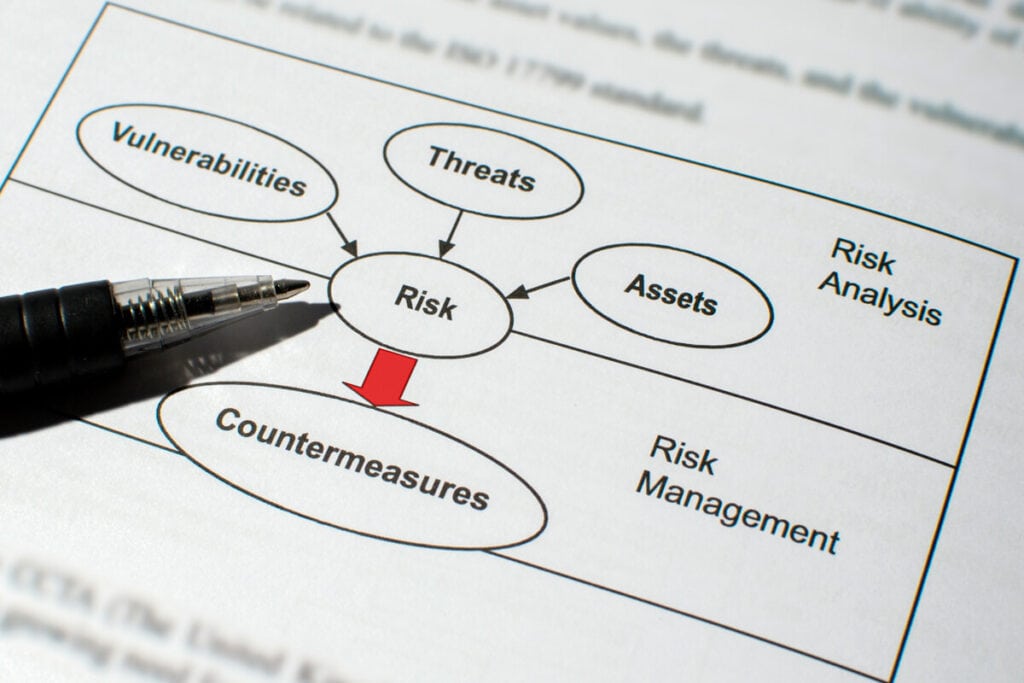Key highlights in this blog
- Understand the nature of business continuity risks and their potential impact on business operations.
- Identify common risk types, including natural disasters and cyber-attacks.
- Learn about the consequences of these risks on business operations and the importance of resilience, recovery, and contingency planning.
- Discover the role of risk management in business continuity planning and how they work together to safeguard operations.
- Get insights into solid planning based on business impact analysis and effective risk assessment strategies.
- Explore implementing continuity strategies, such as prioritizing resilience in organizational infrastructure and utilizing data backup and cloud computing solutions.
Table of Contents
Toggle
Introduction to Business Continuity Risk
Organizations face a wide variety of risks that can disrupt operations. From natural disasters to cyber-attacks, the potential threats are numerous and varied.
Understanding and planning for these risks is more than safeguarding assets; it ensures long-term financial and operational success.
This article explains how to identify and manage risk as part of a holistic approach to successful operations.
What is a Business Continuity Risk?
A business continuity risk is any vulnerability that, if unaddressed, can disrupt a company’s operation. These include internal risks like system failures and human errors and external risks like natural disasters, terrorists, and cyber-attacks. Identifying and mitigating these risks are the first steps in creating a robust business continuity plan.

Common Types of Business Continuity Risk
Business continuity risks can take various forms, including natural disasters, cyber-attacks, supply chain disruptions, legal issues, market fluctuations, and geopolitical events. These risks can disrupt business operations and have far-reaching consequences.
Organizations must understand business continuity risks to plan and respond to potential threats effectively. By identifying these risks, organizations can develop strategies and implement measures to mitigate their impact and ensure the continuity of critical business functions.
Impact of Business Continuity Risks
Business continuity risks can severely impact organizations, disrupting operations, causing financial losses, damaging reputation, and resulting in legal liabilities. These risks affect employees, customers, stakeholders, and the economy. Understanding their impact is essential for developing effective mitigation strategies. Proactive risk management helps minimize disruptions and ensures critical business functions continue smoothly.

Consequences of Natural Disasters on Premises Operations
Natural disasters can severely affect business operations, leading to supply chain disruptions, power outages, physical infrastructure and premises damage, and critical data loss. The consequences of natural disasters on business operations include:
- Disruption of supply chains: Natural disasters can damage transportation networks, warehouses, and distribution centers, leading to delays or interruptions in delivering goods and services.
- Downtime and loss of productivity: Damage to physical infrastructure, such as buildings and equipment, can result in downtime and loss of productivity.
- Loss of critical data: Natural disasters can cause data loss if proper backup and recovery measures are not in place.
- Financial losses: The costs associated with repairing damages, replacing equipment, and restoring operations can result in significant economic losses.
Organizations should have a comprehensive disaster recovery plan to mitigate the consequences of natural disasters. This plan should address data backup and recovery measures, alternative power sources, and contingency plans for supply chain disruptions.

Cyberattacks and Their Effect on Organizational Security
Cyberattacks pose a significant threat to organizational security and can have a detrimental impact on business continuity. These attacks can result in unauthorized access to sensitive data, system outages, and financial losses. The effects of cyberattacks on organizational security include:
- Data breaches: Cyberattacks can lead to data breaches, where sensitive customer information, intellectual property, and financial data are stolen or compromised.
- System disruptions: Malware, ransomware, and other cyber threats can cause system outages and disrupt business operations.
- Financial losses: Cyberattacks can result in economic losses due to theft of funds, legal liabilities, and reputational damage.
Organizations should have a robust business continuity plan that includes data backup and recovery strategies, regular security assessments, and employee training on cybersecurity best practices to mitigate cyberattack risks.

The Role of Risk Management in Business Continuity Management (BCM)
Risk management is critical to ensuring the resilience of a business continuity plan. Organizations can proactively mitigate threats to their vital functions by identifying potential risks and vulnerabilities. Understanding the difference between vulnerability and threat is crucial to formulating effective risk management strategies.
Integrating risk management into business continuity planning enhances the company’s ability to respond efficiently during a disaster, safeguarding operations and reputation. This holistic approach strengthens the organization’s capacity to navigate uncertainties and maintain continuity.

What is the Difference Between Vulnerability and Threat?
Vulnerabilities are weaknesses or gaps in security that could be exploited to harm the organization. These vulnerabilities can exist in various aspects of the organization, including technology systems, physical infrastructure, and internal processes.
On the other hand, threats are potential events or situations that could exploit vulnerabilities and harm the organization. Threats come from various sources, such as natural disasters, cyber-attacks, human error, or internal sabotage.
Identifying vulnerabilities and the threats they expose enables organizations to develop effective risk management strategies and implement measures to mitigate their potential impact.

Integrating Risk Management with Business Continuity Planning
Integrating risk management with business continuity planning results in organizational resilience. This ensures the development of an ongoing practice that identifies risks and their impact on operations and continually improves business continuity recovery efforts, increasing overall operational stability.
Based on regular risk assessments, key stakeholders should develop and maintain a comprehensive business continuity plan that includes business impact analysis, contingency plans, and recovery strategies. This integration ensures that risk management strategies are aligned with the organization’s business continuity goals and enhances the organization’s ability to respond to disruptions and maintain critical business processes.
Developing a Solid Business Continuity Plan (BCP)
Business continuity planning aims to mitigate risks and ensure the continuity of critical functions. The business continuity plan can then act as a roadmap for responding to and recovering from disruptions. A solid plan minimizes disruptions, reduces downtime, and safeguards the organization’s reputation and finances by enabling quick responses and ensuring resilience.
Conducting a Business Impact Analysis (BIA)
Conducting a business impact analysis (BIA helps organizations identify and prioritize critical business processes and their dependencies, understand the potential impacts of any possible situation that causes disruptions to them, and determine the resources and recovery strategies needed to minimize downtime and ensure continuity.
During a BIA, organizations assess the potential impacts of disruptions on various aspects of their operations, including financial, operational, reputational, and legal impacts. By understanding the potential impacts, organizations can prioritize critical business functions, allocate resources effectively, and develop recovery strategies that address the most vital aspects of their operations.

Strategies for Effective Risk Assessment
Risk assessment involves identifying, analyzing, and evaluating potential threats and their potential impact on business operations.
A thorough risk assessment enables organizations to identify and evaluate potential threats to their business operations and develop a comprehensive business continuity strategy.
To conduct an effective risk assessment, organizations should:
- Identify potential threats: Understanding the threats that could impact business operations, such as natural disasters, cyber-attacks, supply chain disruptions, and human error.
- Analyze the likelihood and impact of each threat: Each type of threat should be assessed for organizational vulnerabilities, the likelihood of occurrence, and the consequences of a disaster.
- Evaluate existing controls and mitigation measures: Organizations should evaluate the existence and effectiveness of existing controls and mitigation measures.
- Develop mitigation strategies: Based on the risk assessment, organizations should develop strategies and measures to mitigate the identified risks and ensure the continuity of critical business functions.
Implementing Continuity Strategies to Mitigate Risks
Implementing continuity strategies is essential for organizations to mitigate risks and ensure the continuity of critical business functions. These strategies involve measures that enhance resilience and response capabilities.
Resilience in organizational infrastructure must be prioritized, particularly for vital services. Implementing fail-safe measures within critical functions can prevent disruptions. Diversifying supply chains and using backup power supplies help maintain essential services.
Recovery solutions like data backups and cloud computing are vital for quick data and system recovery during disruptions.
Prioritizing Resilience in Organizational Infrastructure
Resilience refers to an organization’s ability to withstand disruptions and recover quickly. Prioritizing resilience in organizational infrastructure is a key strategy for mitigating business continuity risks.
To prioritize resilience, organizations should:
Identify Critical Functions
Organizations should identify the critical functions and processes essential to their operations and prioritize their resilience.
Implement Fail-safe Measures to Prevent Downtime
Redundancy in systems, processes, and utilities can help prevent disruptions by providing alternative options in case of failures.
Diversify Supply Chains to Avoid Disruption
Relying on a single supplier or location can increase vulnerability to disruptions. By ensuring multiple sources of supply, diversifying supply chains can help minimize the impact of disruptions.
Regularly Review and Adapt
Resilience is an ongoing process. Organizations should regularly review and adapt their infrastructure to new threats and changing circumstances.
Recovery Solutions: From Data Backups to Cloud Computing
Implementing recovery solutions like data backups and cloud computing is crucial for organizations to ensure the continuity of critical business functions.
Recovery solutions can include the following:
- Regularly backing up critical data ensures that it can be recovered while replicating it across cloud storage ensures operational resilience.
- Utilizing cloud computing services allows organizations to store and access critical data and applications remotely, reducing the dependence on physical infrastructure and improving resilience.
- Developing a comprehensive disaster recovery plan outlines the steps needed to recover critical business functions quickly and efficiently.
Adhering to Standards: The Importance of ISO 22301
Standards, like ISO 22301, are crucial for effective business continuity management and risk mitigation. This international standard, BCM, offers a framework and best practices for implementing and maintaining a business continuity management system.
ISO 22301 compliance demonstrates a commitment to safeguarding operations, ensuring the continuity of critical functions, enhancing resilience, and minimizing the impact of risks during disruptions.
The Benefits of ISO 22301
Adhering to ISO 22301 offers several benefits for businesses, including:
- Enhanced resilience
- Minimized downtime
- Compliance and regulatory requirements
ISO 22301 certification also provides a competitive advantage by demonstrating to customers and stakeholders that the organization utilizes robust business continuity management.
Using Technology to Enhance Business Continuity
Technology offers various tools and solutions to streamline and enhance business continuity planning and response.
Two key areas mentioned previously include:
- Cloud computing enables organizations to store and access critical data and applications remotely, reducing the dependence on physical infrastructure and increasing resilience.
- Implementing data backup and replication strategies ensures that critical data remains available or can be recovered quickly during a disaster.
The Advantages of Cloud Solutions in Crisis Recovery
Cloud solutions offer several advantages for organizations in crisis recovery and business continuity. These advantages include:
- Remote data access: Cloud computing enables organizations to access critical data and applications remotely.
- Scalability and flexibility: Cloud solutions offer scalability, allowing organizations to quickly adjust their resources and capacity.
- Cost-effectiveness: Cloud solutions are cost-effective, eliminating the need for significant investments in backup infrastructure.
- Data redundancy and backup: Cloud solutions offer data redundancy and backup, ensuring that critical data is protected and can be quickly restored in the event of data loss or system failure.
Data Backup Strategies as a Continuity Measure
Implementing data backup strategies is essential for organizations seeking to ensure the continuity of critical business functions in the event of data loss or system failure. These strategies involve regularly backing up critical data and storing it in secure locations.
The benefits include:
- Minimized downtime: With up-to-date backups of critical data, organizations can quickly recover and resume operations in the event of data loss or system failure.
- Protection of essential services: Data backup strategies ensure that essential services can continue uninterrupted, minimizing the impact on business operations.
- Mitigated risks: By implementing data backup strategies, organizations mitigate the risks associated with data loss, such as financial losses, reputational damage, and legal liabilities.
Conclusion
Creating a robust Business Continuity Plan (BCP) involves strategic risk management, resilience, and recovery strategies. Understand the risks and develop a BCP with business impact analysis, risk assessment, and resilience strategies. Implement ISO 22301 standards and technology like cloud solutions for crisis recovery. Regularly test your BCP to enhance security and operational reliability.




